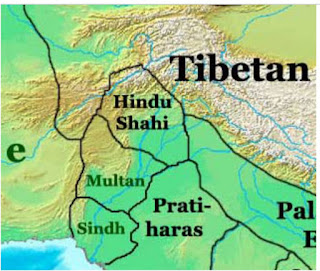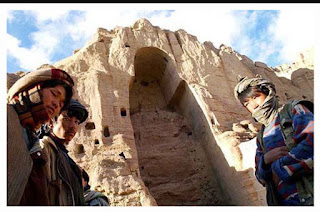Gandhara was an ancient Indian kingdom mentioned in the Indian epics Mahabharata and Ramayana. Gandhara prince Shakuni was the root of all conspiracies which resulted in the Kurukshetra war which popular tradition dates back to 3102 BC. Shakuni's sister was the wife of Kuru king Dhrishrashtra and was known as Gandhari. Subala was the king of Gandhara in the Mahabharata. His son Shakuni lived in the Court of Kuru as a councilor of King Duryodhana.
Gandhara was a triangular tract of land about 100 km east to west and 70 km north to sound, lying to the west of Indus River and bounded on the north by the Hindukush mountains. The region across the Indus extended westwards into the Kabul valley in Afghanistan, northwards up to the Karakoram range and extended till Peshawar valley, the hills of Swat, Dir, Buner and Bajaur. Indeed during certain times, the influence spread till Sindh
Map showing the Gandhara region amongst Mahajanapadas
Gandhara witnessed the rise of eleven great kingdoms like the Kushans and the Mauryan. It was in its heyday from 600 BC to 1000 AD, until it succumbed to the onslaughts of the Ghaznavids and was soon reduced to a wasteland. Its past glory remaining shrouded in dust until the British, in the nineteenth century, began excavating and rediscovering a lost piece in the puzzle that is ancient Indian history.
Gandhara has been referred to in the Rigveda (1500-1200 BC). It was one of the sixteen mahajanapadas of ancient India, mentioned in the Buddhist sources such as Anguttara Nikaya. Gandhara was conquered by the Persian Emperor Darius (Achaemenid Empire) in the 518 BC, conquered by Alexander in 327 BC, became part of the Maurya Empire and then the Indo-Greek Empire. It was also the Centre of Buddhism. The primary cities of Gandhara were Pushkalavati, Purusapura (Peshawar) and Taxila.
During the Ramayana time, King Nagnajit, who was a contemporary of Lord Rama, was defeated and killed by Rama's brother Bharat.
Bharat's two sons Taksha and Pushkala established Takshasila (Taxila) and Pushkalavati on either side of Indus River. These were part of Gandhara.
Gandhara literally means "perfume". It survived from the sixth century BC to the eleventh century AD. It attained its high point from the first century to the fifth century AD under Buddhist Kushan kings. After it was captured by Mahmud of Gazni in 1021 AD, the name Gandhara was changed and later the place was totally destroyed.
Map showing Gandhara.
Macedonian Gandhara (327 to 324 BC). In the winter of 327 BC, Alexander invited all chieftains of the satraps to submit to his authority. This was done after his successful capture of the Persian Empire. The ruler of Taxila, Ambhi, complied, but the other tribes in the former satraps of Gandhara rejected the offer. In fierce and quick battles Gandhara was captured and Alexander's forces combined with King Ambhi of Taxila crossed the Indus River in 326 BC to begin the Archosia (Punjab) campaign.
Maurya Empire (324 to 185 BC). By 316 BC, King Chandragupta of Magadha moved and conquered the Indus valley annexing Gandhara and naming Taxila a provincial capital of his empire. He was succeeded by his son Bindusara, who was succeeded by his son Ashoka. Ashoka spread Buddhism and one of the stupas where he buried several relics is Dharmarajika Stupa at Taxila.
Maurya Empire, 250 BC.
Indo-Greek Empire (250 to 190 BC). In 184 BC, the Greeks invaded Gandhara under King Demetrius, and he built a new city on the opposite bank of the river Indus. This is now known as Sirkap (meaning 'severed head'). This kingdom extended from Arachosia (modern-day Kandahar in Afghanistan), Punjab and part of Ganges valley. Menander I was its most famous king. He ruled from Taxila and later from Sagala (Sialkot).
Indo-Greeks, 180 BC.
Indo-Greeks,100 BC.
Menander Silver Tetradrachm, 155–130 BC, weight 7.8 gm
Obverse, Diademed bust viewed from behind, brandishing spear in right hand and in aegis on left shoulder.
Reverse, kharoshti legend, Athena Alkidemos holding shield, M in left field, monogram in right field.
Menander, silver Drachm, 160–145 BC, weight 2.35 gm
Obverse helmeted and draped bust of Menander.
Reverse, Athena walking left, brandishing a spear and holding a shield.
Menander Silver Drachm, 160–145 BC, weight 1.7 gm, Pushkalavati mint
Obverse, Diademed draped bust.
Reverse, kharoshti legend, Pallas Athena standing left, holding aegis in left arm and hurling thunderbolt with right, HA monogram.
Apollodotus 1, AR silver Drachm, 174-165 BC, 2.36 gm
Obverse, elephant standing right.
Reverse, Zeba bull standing right.
Graeco-Bactrians, Sakas (called Scythians by the Greek) and Indo-Parthians. Around the time of Menander's death in 140 BC, the Kushans overran Bactria and ended the Greek rule there. Around 80 BC, the Sakas, moved into Gandhara. The famous king of Sakas, Maues, established himself in Gandhara. In 50 BC, the Parthians put an end to the remnants of Greek rule in today's Afghanistan. Eventually an Indo-Parthian dynasty succeeded in taking control of Gandhara. King Gondophares was the ruler.
Indo-Parthan, Gondophares Drachm, 1st century BC to 1st century AD, weight 2.7 gm
Kushan Empire (1st to 5th century AD). They migrated to Gandhara around the 1st century AD from Central Asia and Afghanistan. They selected Peshawar as their capital. Later they expanded into the heartland of India to establish the Kushan Empire, which lasted till the 3rd century AD. In 80 AD, they captured Gandhara from the Parthians. Taxila was founded again and named Sirsukh. It was surrounded by a six-meter-thick wall that was 5 km long. It became a hub of Buddhist activities and was a period of golden age in the history of this region.
Kushan Empire, 1st to 5th century AD.
Obverse: King facing left sitting on throne wearing robe, trousers and boots. Greek legend around
Reverse: Oesho standing with trident in hand leaning on a bull. Karosthi legend, maharajasa rajadhirajsa sarvaloga isvarasa mahisvarasa vima kathpisasa tradara.
Vasudeva I, tetradrachm, 195-225 AD, weight 8.8 gm
Obverse: diademed king standing facing, nimbate, holding trident and sacrificing at altar at left, Bactrian legend
Reverse: Shiva standing holding trident and diadem, bull Nandi left behind, tamgha at right.
Towards the end of the Kushan rule, duration rule of some dynasties is recorded. Quick succession rule by the Sassanian Empire, Kidarites (or little Kushans) and finally the White Huns.
Sasanian Empire from 226 to 651 AD.
Hephthalite Empire. White Huns of Central Asia ( 5th century AD). The Kidarites ruled till the middle of the 5th century AD when the White Huns, or Hephthalites invaded the region and caused physical destruction. After some years the Huns adopted the Shaivite faith. The importance of Buddhism began to wane. With the White Huns' alliance with the Gupta Empire against the Sassanians also caused the Centre of Buddhism to be subdued and this religion moved up through the northern passes into China and beyond. Hinduism then spread.
White Hun Empire. 5th century AD.
Kabul Shahi. The term is used to denote two former non-Muslim dynasties, the Turk Shahi and the Hindu Shahi. After the fall of the Sassanid Empire to the Arabs in 651 BC, the region south of the Hindukush along with Gandhara came under pressure from the Muslims. Gandhara was ruled from Kabul for the next 200 years by the Kabul Shahi. They were supporters of Buddhism and are generally presented as Buddhists.
Sometimes in the ninth century the Kabul Shahi was replaced by the Hindu Shahi. This was around 850 AD. Kallar, a Brahmin founded the dynasty. They ruled from Kabul and resisted the Muslim expansion of the Abbasid Caliphate, effectively blocking the Muslim conquests, until it fell to the Persian Saffarids. In 1021, the last king of the dynasty Tirlochanpala, was assassinated and it spelled the end of Gandhara.
The Hindu Shahi areas
Kabul Shahi, Spalapati Deva, 750-900 AD, weight 3.42 gm
Bull siting left, trident mint mark on bull, Nagari legend: Sri Spalapati Deva
The remaining few centuries saw constant invasions from the west, especially Muslim conquest. Mahmud Ghazni, who conquered Gandhara in 1001 AD, has been marked as the destroyer of Gandhara, and he left it as a desolate waste. He was the first ruler of the Ghaznavid dynasty who ruled from 998 to 1030 AD. The numerous stone-built cities, monasteries with their valuable and revered monuments and sculptures, were sacked, razed to the ground and destroyed.
The old cities and worship places of importance fell out of memory for the next 1500 years until they were rediscovered in the mid 1880 AD by the British explorers.
Some years back, the Taliban targeted Gandhara Buddhist relics and destroyed all the ancient statues in Afghanistan.
Bamiyan: Buddha statue, photo @ Thewait 1974.
Destruction of Bamiyan Buddha, 2001, Photo@ Taysir Alony.




























































Firstly , thanks for this researched blog and photo display of beautiful coins. It's qmazing that you have these in your collection .
ReplyDeleteThe study done displays such an amazing graphic art display - Alpana
Fascinating! Each artefact in your collection would have a story to tell about centuries and millenia past
ReplyDeleteI am really impressed with the wealth of knowledge deciphered from coins. Great stuff
ReplyDelete